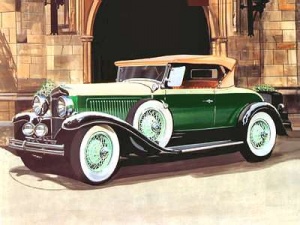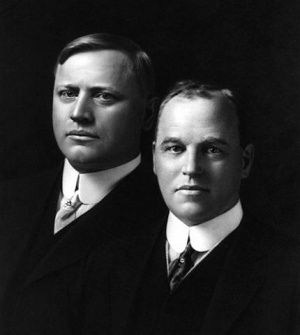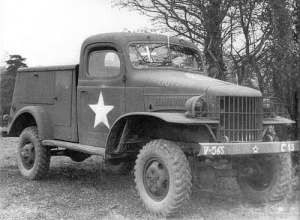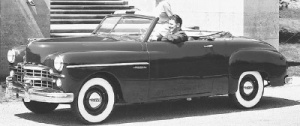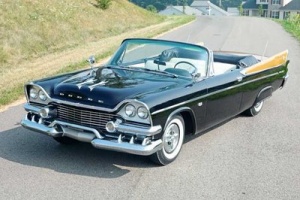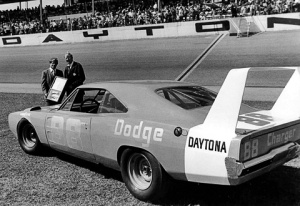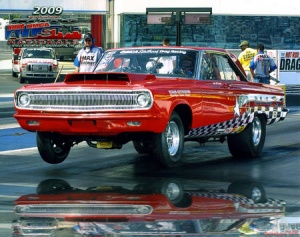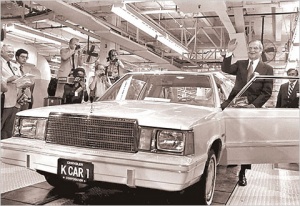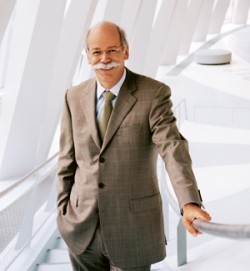Dodge
Contents
- 1 Introduction
- 2 Dodge Brothers
- 3 Chrysler Buys Dodge Brothers
- 4 WWII
- 5 Postwar Styling
- 6 Red Ram Engines
- 7 Forward Look Styling
- 8 The Sixties
- 9 The Seventies and Eighties
- 10 ""Merger of Equals""
- 11 After Dr. Z
- 12 2009 Bankruptcy and Restructuring
- 13 Wiki Topic References:
- 14 Magazine and Book References:
- 15 External Links
Introduction
Despite all of the ups and downs of the Chrysler Corporation -- Dodge has always been able to show an excellent mixture of both dependability and performance with both its cars and trucks. This was initially promoted by General "Black Jack" Pershing insisting on only Dodge Touring cars in his pursuits of Poncho Villa on the Mexican border.
Dodge was the first with an all metal sedan, it set the standard for durability with its WWII Power Wagons, set the standard for racing with its Max Wedge and Hemi engines, set the standard for Muscle cars with the Charger, set the standard for aerodynamics with the Daytona, set the standard for performance with the Viper, and set the standard for "Cross Over" vehicles with the Magnum. While its future with an Un-Holy Trinity of Fiat, the US Government, and the Unions running it being uncertain -- its past as a Make that merged Durability and performance cannot be denied.
Dodge Brothers
John Dodge and Horace Dodge were inseparable as children and adults. They were in fact so close, they they both died as young men in 1920 -- it said the Horace out of grief from the loss of John.
Originally they built bicycles, but in 1900 they formed Dodge Brothers to supply engine and chassis components for Detroit's automakers; with a large contract to produce transmissions for Oldsmobile. John was the Sales/Manager brother, while Horace was the tinkerer/engineer brother.
In 1903, they signed a contract to supply components exclusively to Ford, in exchange for a large share of the company. This arrangement lasted for 10 years -- until 1913 they and Ford had a major disagreement on how Ford's profits were distributed -- causing them to stop supplying Ford and to declare that they would start building cars themselves.
Before the first Dodge Brothers car was produced, they had sign up over 20,000 dealers because of their reputation for quality. It should be noted that while they had a reputation for quality, were among the richest men in Detroit, and very generous in their charitable foundations -- their crude and aggressive behavior kept them from being accepted by the by Detroit elite.
In late 1914, the first Dodge Brothers car rolled off the assembly line and was an immediate hit with the public. For about the same price as a Ford Model T -- a Dodge Brothers had an electric starter, leather interior, a windshield, near double the horsepower, and a far superior three speed transmission. They went from no where to fourth in US car sales.
In January 1920, John died of pneumonia, a complication from the Spanish Flu; and Horace died in December of the same year, also of pneumonia as a complication of the Flu -- but was already dying of Cirrhosis of the liver, rumored to be caused from excess drinking after the loss of his brother. The ownership of Dodge Brothers fell into the hands of their widows, and they chose a long associate of the Dodge brothers, Frederick J. Haynes, to run the company. He signed a contract with Graham Brothers to power and sell their line of trucks. On April 1, 1925, the banking firm Dillon, Read & Company purchased Dodge Brothers from the Dodge widows for $146 million.
Dillon, Read formed a new company on April 8, 1925, Dodge Brothers, Inc., under Maryland laws to assume the assets and liabilities of the old company. The new firm issued non-voting stock and along with a series of bonds sold on the market raised $159 million for Dillon, Read. Dillon, Read controlled all the voting stock in the firm and Fredrick Haynes remained with the company.
Dodge Brothers acquired complete control of Graham Brothers on May 1, 1926, and the three Graham brothers assumed management roles with Dodge Brothers. The three brothers would depart early in 1927 and acquire Paige-Detroit Motor Company to form Graham-Paige Motors Corporation, a company that would have connections with Chrysler in the 1940's.
By 1928, with sales of Dodge Brothers vehicles dropping, Dillon, Read decided to look for a new owner of Dodge Brothers.
Chrysler Buys Dodge Brothers
On July 31, 1928, Walter P. Chrysler bought Dodge Brothers to fold into his tier of makes that included Chrysler, the new DeSoto, and newly created price leader Plymouth. By the time of the purchase, Dodge Brothers had designed and introduced three new six cylinder lines, Standard, Victory and Senior. The first Chrysler-designed Dodges would not arrive until the 1930 model year when Chrysler shortened the Dodge Brothers name to just Dodge.
In 1930, and at about the worse possible time, Chrysler gave the Dodge DC model a straight eight, which displaced 220.7 cubic inches and was rated at 75hp. Desoto also had models with a "Straight Eight" engine for 1930 and Chrysler introduced a new Eight and Imperial Eight for 1931. While displacement and power increased, because of the Depression, these models sold poorly, and the "Straight Eight" was discontinued for Dodge in 1934. The sole engine was now the 217 CI "Straight Six", rated at 87hp.
In 1935, the 3,000,000th Dodge rolled off the assembly line. In 1939, Dodge was restyled as a Fastback with a V Windshield, which many claimed looked more like a 39 Ford -- than a 39 Ford. During this time, after recovering from the "Straight Eight" error in judgment, Dodge placed between 4th and 5th in US Sales.
WWII
As the case for all US Automakers, all civilian sales were pulled following Pearl Harbor and the US' entry into WWII. Dodge would produce the majority (about 500,000) of the Military trucks -- led by the G-502 3/4 Ton, which would evolve into the Power Wagons. Production of the Power Wagons lasted until 1968.
Postwar Styling
Dodges produced after the end of WWII were pre-war models with mildly updated front grills.
That changed in 1949 with a clean redesign of the car and model designations of Wayfarer, Meadowbrook, and Coronet. Dodge continued in the Top Five of US Sales during this period.
Red Ram Engines
In 1953, and after a 20 year absence of an eight cylinder motor, Dodge wasn't just given an engine -- but a First Generation Hemi V-8 version of Chrysler's 331ci engine -- displacing 241.3ci and rated at 140hp. This engine was known as the Red Ram. This new engine would forever transform Dodge's image, and resulted in its entry into the world of racing. Over the next few years Dodge would offer versions of this engine for NASCAR. The first generation Hemi was discontinued for 1958 because of high production costs -- and replaced by new corporate Wedge B block engines.
Dodge offered a poly head version of their hemi starting in 1955. That engine would be replaced by the A block poly for 1959.
Forward Look Styling
Dodge received another restyling for 1953 -- but to many, Chrysler's President (K. T. Keller) requirement for a high roof line to allow men to drive with their hats on -- made the car look too stodgy.
This was to soon change when Virgil Exner left Studebaker Corporation in 1949 (he worked for Raymond Loewy Group, who had the Studebaker styling contract, until fired in 1945) for Chrysler and ultimately would head up the design of Chrysler. Under Exner, all of the 1955 Chrysler Corporation makes acquired a longer, wider, lower look, and sprouting tail fins -- called the Forward Look. Exner's designs were very bold and futuristic -- and set the trend followed by the other US automakers. The last year of the fins was 1961 when the Dart and Polara had backward fins. In 1962 Plymouth and Dodge took on a very bizarre look similar to the new compacts Valiant and Lancer -- only larger.
In 1962, all Chrysler makes were due for a major update. When the designs were in the final stage, Chrysler executives were played by GM executives who were showing them the Chevy II (after already having a compact car -- the Corvair), and making Chrysler believe that they be the only manufacturer that wouldn't be downsizing their cars for 1962. In a panic -- Exner was immediately order to dramatically reduce the size of the 1962 model cars. Exner objected, saying that the design couldn't be made to look right while chopped up -- but it fell of deaf ears. The cars were ugly, and didn't sell well. Exner was offered up as the sacrificial lamb -- by being fired.
Elwood Engel (who had just designed the new slab sided suicide 4-door Lincoln) was hired away from Ford and put in charge of Chrysler Corporation's design studio. His designs wouldn't appear until 1964 (Imperial) and 1965 with the larger C-Body models. Meanwhile, Dodge dealers screamed about not having a full size car to sell, and so shortly after the release of the 1962 models they were given a model called the Custom [[880]. The Custom 88 was basically a 1962 Chrysler Newport (itself a 1961 Polara with a 1961 Chrysler front end and new rear quarters) with a 1961 Dodge front end and instrument panel fitted to it .
The Sixties
The Sixties saw Dodge with the Lancer, later renamed Dart as its compact car; the 330, 440 and Polara models later renamed the Coronet as the intermediate line for 1965; the Polara as the full size model replacing the Custom 880; and the Monaco as the personal luxury model. In 1966, a 2-door hardtop Coronet had a fastback roof grafted on, was given hidden headlights and full length tail lights, and a cool dash -- and thus the Charger was born to compete for Muscle car dollars.
Higher performance Darts were called the Dart GT and Dart GTS. Coronets that were given a 375hp 440, Six-pack 440, or 426 Hemi were the RT model. In 1968, Plymouth took a stripped Satellite and put a 383 (or 426 Hemi) in it and called it a Road Runner. It was very popular with young people. For 1969, Dodge took a Coronet and did the same -- calling it the Super Bee.
In the Sixties we saw High Impact Colors, the 426 Hemi, the six-pack, Scat Pack, White Hat Dealers, and Sheriff Joe Higgins.
Racing
For much of the 1960s, Dodge owned the race tracks across the United States.
NASCAR
Dodge had been popular in NASCAR since the mid 50s and its D-Series of engines. However, in the early 60s Ford, Mercury, and Pontiac had evened the field. That all changed in 1964 when Richard Petty threatened to leave Plymouth if they couldn't find a way to give him a dominant car. The dust was blown off the old Hemi idea -- and a new generation Hemi displacing 416 CI was created and put into enough street cars to make legal for NASCAR racing for both Plymouth and Dodge. The engines were immediately dominant, so dominant that NASCAR tried everything they could to handicap those drivers with the Hemi engines -- until many driver (including Richard Petty) boycotted NASCAR.
By 1969 most of the other manufacturers had caught up with Dodge and Plymouth, and the new style Charger had an aerodynamic flaw with the rear window cove and the grill set too far back. To fix, a model of Charger called the Charger 500 had the fenders and grill of a 68 Coronet replacing those of the Charger, and a rounded rear window plug to smooth out the back. While the car was a success -- Ford and Mercury countered with the Talledaga and Cyclone Spoiler. Dodge immediately countered that with a bullet shaped nose, extended fenders with holes and scoops for the front tires (as the nose created a lot of down force), and a huge rear wing. The car was called the Daytona, and was an instant winner. For 1970, Plymouth instead got the aero/winged design and Dodge dropped it -- as only one of Chrysler makes could afford to make enough of the loss leader to make it legal in NASCAR. Some say that Plymouth got it because there were fewer dealers (the number produced to make legal was based on the number of dealers) and some say that Richard Petty refused to drive a Dodge.
It was all for naught -- as in 1971 NASCAR penalized the winged cars by forcing them to run a 305ci small block. Another case of Dodge and Plymouth getting too good for the competition -- so they had to dumb down to the level of the competition.
In the late 70s, Dodge was in bad financial shape and not giving their drivers capable cars. Richard Petty started off 1978 with a Dodge Magnum, but hated it and went to a Monte Carlo and later a Cutlass -- giving the Magnum to his son Kyle Petty. That car was later sold to Buddy Arrington, who went down to a Mirada, then a Cordoba, and finally an Imperial. Buddy was the last to drive a Mopar for many years -- as there was no longer any factory support.
About 20 years later Dodge made a comeback to NASCAR with factory support. While it had many good drivers and a brief period of success -- the lack of factory support once Chrysler merged with Daimler-Benz had that success short lived. It is suspected that there will not be a Mopar in Cup racing for NASCAR in 2010.
Drag Racing
In the early 60s, Dodge dominated Super Stock drag racing with the Max Wedge Engines, and their slightly smaller body styles. In 1964, they turned the wick up even more -- with the rebirth of the second generation Hemi. Drivers like Bill 'Maverick' Golden, Dick Landy; and car with names like Color Me Gone and Motown Missile kept alive the concept of "Win on Sunday -- Sell on Monday" at Dodge Dealers. In 1968 and 1969 -- a very limited number of a "race only" version of the Dodge Dart Hemi and Plymouth Barracuda Hemi was sold to select Drag Racers. These cars still hold Super Stock Records today.
Super Stock evolved into Pro Stock -- and drivers chose smaller Dodge body styles like the Challenger, Dart, and Demon were the Dodges most often Chosen. FX/Altered evolved into Funny Car and the Charger was the most popular flopper. Like in NASCAR, Mopar cars were receiving too many restrictions so the other makes could compete -- and Mopar's involvement disappeared for many years. Recently a slight comeback was made by Mopar in Pro Stock and Funny car -- but factory backing is minimal and expected to dry up now that the UnHoly Trinity is running Chrysler.
The Seventies and Eighties
The beginning of the 70s saw both the Government and the Insurance Industry trying to put an end to the Muscle Car and the Convertible. They were successful in cutting horsepower and adding weight in the name of safety. Cars got bigger and bigger until the first Oil Embargo in late 1973. While Americans started to trade in their Vista Cruisers for Corollas -- most American Manufacturers thought of this as just a phases and cars got bigger and bigger until around 1975-1976. This error in judgment, combined with the UAWs extortion resulting in poor build quality and constant strikes allowed the imports to get their feet in the door, and was the beginning of the end for US automakers. Chrysler Corporation was even a little later than Ford and GM with down-sizing, and didn't start in earnest until about 1978.
The last of the second generation Hemis was in 1971 -- as was the last of the 6-pack cars. 1971 also saw the body style change to the "Coke Bottle" styling -- with rounder fuselages.
1972 saw horsepower drop dramatically, and become rated using the Net (vs. Gross) method. Pollution control devices started to make their appearances.
1974 was the last year of an 8 3/4 axle package for performance. The Dana 60 had stopped appearing in cars a few years earlier.
1975 saw the B-Body receive its final redesign to a Isolated suspension, to smooth it out the ride for Chrysler's new personal luxury car Cordoba. This platform is referred to as the Forgotten B-Body and was discontinued after 1979 in favor of the smaller J-Body, which was a stretched F-Body.
1976 saw the A-Body Dart being replaced by the F-Body Aspen.
1978 saw the M-Body appear for start of downsized Dodges, such as the Diplomat.
1978 saw the end of the RB (raised Block) 440. It also saw the two-year only Dodge Magnum, which was initially planned to be the Charger for 1978. The front end styling was so radical -- that Dodge executives got cold feet and carried over the 1977 Charger into 1978 just in case. Many believe that the Magnum was one of the few bright spots in the dark disco ages. The Magnum was replaced by the J-Body Mirada in 1980, when the B-Body was discontinued.
In 1979, the smaller R-body replaced the C-Body -- for large Chryslers and the new Dodge St. Regis.
The end of the 70s had Chrysler in deep financial trouble, and Lee Iacocca trying to figure out how to save the Corporation.
Lee Iacocca created a budgeted plan that eliminated all large cars, created a 4-cyl FWD platform called the K-Car -- which all future models would be based on, and made no changes to the truck line. He then negotiate a loan from the government and restructured the "The New Chrysler Corporation". The plan worked, the loan paid back early, and black ink ran freely.
The K-Cars were uninspiring to look at -- but they did save Chrysler with their versatility. The first mini-van was created off that platform -- as was the return of the convertible in the K-Car LeBaron.
Moving into the 90s, profitability allowed the luxury of redesigning the Dodge Ram trucks to have a baby Kenworth look -- rocketing Dodge into the most popular pick up. It also allowed them to create great concept vehicles like the Viper, PT Cruiser, Prowler, Crossfire, and Magnum -- and then bring them to market. Dodge created a a midsize pickup with a V-8 called the Dakota -- and then gave it the baby Kenworth look. The Dakota in turn was used as the basis of a midsized SUV, called the Durango.
Later in the decade a new platform called the LS/LX was created for the Chrysler 300, Dodge Charger, and the Dodge Magnum. That in turn would be the basis for the return of the Dodge Challenger.
""Merger of Equals""
In May of 1998, Chrysler and Daimler-Benz announced "The Merger of Equals" between the two corporations. However, many people now believe this "Merger of Equals" was a lie, and that the real reason of the merger was Chrysler Executives selling out the Stockholders and Mopar Loyalist to line their personal pockets with severance money -- while Mercedes no longer having to pay a tariff for their cars to enter the United States.
It was a marriage made in Hell -- and by 2000, Mercedes announced that it considered Chrysler as a subsidiary of Mercedes.
While Dodge Rams trucks, Chrysler 300s and Dodge Chargers were selling like Hot Cakes -- the Chrysler Division was treated like a Red-Headed step child and shopped.
After Dr. Z
An 80% stake in Chrysler was ultimate sold to Cerberus Capital Management -- which had a reputation of being "Slash & Burn" company, one who typically dismantles companies that has the sum of its parts worth more than the whole.
Within two years, there was barely enough left of Chrysler LLC for burial rights, and the Chrysler was facing bankruptcy.
2009 Bankruptcy and Restructuring
Shortly after becoming President, Barrack Obama loaned Chrysler LLC money from the public treasury -- with what many people believe were unreasonable restrictions.
Shorty thereafter, Chrysler was forced into bankruptcy and merged with Fiat and the UAW obtained majority stock ownership, although Fiat gained control of the company. Some people believe that Chrysler's secured bond holders were not repaid as law requires and were instead forced to take pennies on a dollar.
(The UAW's stock is actually a trust fund to pay for Chrysler retiree's health care. Chrysler had not been paying its share of the employees' pension contributions into the fund, owing $10.6 billion as of June, 2009. As Chrysler's position improves, all dividends earned by the stock owned by the trust fund will be placed into the fund, and if any stock is sold the proceeds will likewise be placed in the fund. The UAW - trust fund has 55% of the stock, Fiat is next at 20% with the U.S. (8%) and Canadian (2%) governments bringing up the rear. The 'new' Chrysler Group LLC does not at present sell its stock on stock market and is considered a 'private' corporation.)
(Although the UAW trust fund is the largest stockholder, Fiat has control of the company and will eventually own 35% of Chrysler stock. Fiat had been in financial difficulty a decade ago, but now is profitable building cars that have been well received in Europe. They also have a larger presence in South America, Europe, and Africa than Daimler which will help Chrysler increase its foreign presence, as well as supplying the platforms to permit Chrysler to quickly enter the small car market.)
(On November 6, 2009, Fiat announced its plans for Chrysler. The Dodge car will remain and will be expanded with new smaller vehicles to replace the Caliber. As well, new Avenger models will be introduced based on a Fiat platform as well as a new Charger. Dodge Trucks will now be known as Ram Trucks with poor selling models to be dropped and new, improved models to come on line in the next two to three years.)
(According to Fiat's plans Chrysler will be showing an operational profit in 2010 and repay the government loans within a decade. Chrysler ended the 3rd quarter of 2009 with $5.7 billion in cash, up from $4 billion three months earlier, with $2 billion in government loans that have not yet been drawn upon. Chrysler showed a small profit for the month of September, 2009.)
(Chrysler's biggest problem right now is to stop the plunging sales figures in the U.S. Chrysler will end the year with about one million sales world wide but needs 1.6 million to break even. The Canadian and Mexican subsidiaries, neither had to declare bankruptcy, are fairing better for sales although not at the levels of two years ago.)
Wiki Topic References:
Magazine and Book References:
- Hemmings Classic Car June 2007
- A Financial History of the American Automobile Industry; Lawrence H. Seltzer; Hart, Schaffner & Marx, 1928
- Ward's Automotive Yearbook; various issues 1951 through 2000.
External Links
Random Page | Longest Wikis | Oldest Wikis | Newest Images | Newest Wikis | List of Categories | List of Every Freakin Wiki
- Register to Edit
- It takes less than 5 minutes to request registration for editing, and we try to approve within 24 hours. Click the Register Link in the Top Bar.
- MoparWiki Help
- While editing Wikis may at first glance appear a little overwhelming, it really isn't. You will find this site's HELP (link found in the sidebar) to be very strong and easy to understand. The best way to start is with small edits and working on your user page -- and you will become a Pro in no time.

